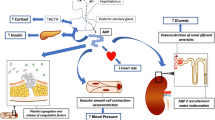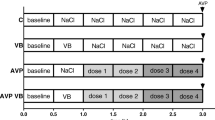Abstract
Some analogues of arginine vasopressin (AVP) reportedly possess hypotensive properties, and two such peptides are Cys1-Tyr2-Phe3-Val4-Asn5-Cys6-Pro7-d-Arg8-Gly9-NH2 (VD-AVP) and d(CH2)5-Cys1-d-Tyr(Et)2-Arg3-Val4-Asn5-Cys6-Lys7-Lys8-ethylenediamine9 (TA-LVP). In the present investigation we examined the effects of TA-LVP (0.3, 1.0 and 3.0 μg/kg/min), VD-AVP (0.3, 1.0 and 3.0 μg/kg/min) and AVP (1.0, 3.0, 10 ng/kg/min) on haemodynamics, blood volume (BV) and plasma troponin levels in anaesthetised rats. Infusion of TA-LVP significantly (P<0.05) reduced blood pressure (−45±3%; n=8; mean ± SEM), mean circulatory filling pressure (Pmcf; −41±3%), and cardiac output (CO; −59±4%). The reduction in CO at a lower dose of TA-LVP was due to reduced venous tone, while at higher doses the reduction was predominantly the result of reduced BV (−35±4%). The large decrease in BV during the infusion of TA-LVP, substantially increased resistance to venous return (50±11%), which was the main contributor in reducing CO. Administration of AVP significantly increased blood pressure (41±4%) and arterial resistance (98±16%) without any impact on Pmcf and BV, while significantly reducing CO (−26±5%). Infusion of VD-AVP did not produce hypotension, but produced a modest but significant reduction in CO (−18±5%) and insignificant but moderate increases in peripheral resistance (30±12%) and resistance to venous return (28±8%). Plasma troponin levels were not affected by any of the peptides. The hypotensive action of TA-LVP was due to a reduction in CO as a result of a reduced pre-load, while the pressor effect of AVP increased after-load sufficiently to impede flow, reducing CO. VD-AVP was devoid of any hypotensive effects, suggesting that V2-vasopressin receptors are most likely to play a limited role in the control of cardiac and vascular function in these animals.




Similar content being viewed by others
References
Abboud FM, Floras JS, Aylward PE, Guo GB, Gupta BN, Schmid PG (1990) Role of vasopressin in cardiovascular and blood pressure regulation. Blood Vessels 27:106–115
Chan WY, Levi R, Wo NC, Koyama M, Stoev S, Cheng LL, Manning M (2001) Novel selective hypotensive vasopressin peptides: cardiovascular and structure-activity-relationship studies. Eur J Pharmacol 419:65–72
Cheng LL, Stoev S, Manning M, Wo NC, Chan WY (2001) Design of more potent, radioiodinatable and fluorescent vasopressin hypotensive peptide agonists. In: Lebel M, Houghton RA (eds) Peptide: the wave of the future. American Peptide Society, San Diego, pp 978–979
Eichinger MR, Russ RD, Walker BR (1994) Potassium channels are not involved in vasopressin-induced vasodilation in the rat lung. Am J Physiol 266:H491–H495
El-Sayed H, Goodall SR, Hainsworth R (1995) Re-evaluation of Evans blue dye dilution method of plasma volume measurement. Clin Lab Haematol 17:189–194
Hirsch AT, Dzau VJ, Majzoub JA, Creager MA (1989) Vasopressin-mediated forearm vasodilation in normal humans. Evidence for a vascular vasopressin V2 receptor. J Clin Invest 84:418-426
Liard JF (1988a) Vasodilation induced by specific vasopressin V2 agonist in dogs. J Hypertens 6 [Suppl]:S673–S674
Liard JF (1988b) Effects of a specific antidiuretic agonist on cardiac output and its distribution in intact and anephric dogs. Clin Sci 74:293–299
Liard JF (1989) Peripheral vasodilatation induced by a vasopressin analogue with selective V2-agonism in dogs. Am J Physiol 256:H1621–H1626
Liard JF (1994) l-NAME antagonizes vasopressin V2-induced vasodilatation in dogs. Am J Physiol 266:H99–H106
Manning M, Stoev S, Cheng LL, Wo NC, Chan WY (1999) Synthesis and structure-activity investigation on novel vasopressin hypotensive peptide agonists. J Pept Sci 5:472–490
McNeill JR (1983) Role of vasopressin in the control of arterial pressure. Can J Physiol Pharmacol 61:1226–1235
Medina P, Segarra G, Vila JM, Chuan P, Domenech C, Lluch S (1999) V2-receptor mediated relaxation of human renal arteries in responses to desmopressin. Am J Hypertens 12:188–193
Migita R, Gonzales A, Gonzales ML (1997) Blood volume and cardiac index in rats after exchange transfusion with hemoglobin-based oxygen carriers. J Appl Physiol 82:1995–2002
Pang CCY (1983) Effect of vasopressin antagonists and saralasin on regional blood flow following hemorrhage. Am J Physiol 245:H749–H755
Pang CCY (1994) The effect of drugs on venous system. Medical Intelligence Unit, Lands, pp 17–42
Pang CCY (2001) Autonomic control of the venous system in health and disease effects of drugs. Pharmacol Ther 90:179–230
Pang CCY, Tabrizchi R (1986) The effect of noradrenaline, B-HT 920, methoxamine, angiotensin II and vasopressin on mean circulatory filling pressure in conscious rats. Br J Pharmacol 89:389–394
Russ RD, Walker BR (1992) Role of nitric oxide in vasopressinergic pulmonary vasodilation. Am J Physiol 262:H743–H747
Russ RD, Resta TC, Walker BR (1992) Pulmonary vasodilator response to neurohypophyseal peptide in the rat. J Appl Physiol 73:473–478
Schenk J, Hebden A, McNeill JH (1992) Measurement of cardiac left ventricular pressure in conscious rats using a fluid-filled catheter. J Pharmacol Toxicol Methods 27:171–175
Shimizu K, Schwartz J, McGrath BP (1993) Baroreflex buffering of pressor response to vasopressin is mediated by V1, not V2 receptors in conscious rats. Am J Physiol 264:R345–R349
Tabrizchi R (1997) Effects of adenosine and adenosine analogues on mean circulatory filling pressure and cardiac output in anaesthetized rats. Naunyn-Schmiedebergs Arch Pharmacol 356:69–75
Tabrizchi R, Ford CA (2003) Haemodynamic effects of endothelin receptor antagonist, tezosentan in tumour necrosis factor-α treated anaesthetized rats. Naunyn-Schmiedebergs Arch Pharmacol 367:156–167
Toda M, Ayajiki K, Okamura T, Azuma I, Toda N (1998) Desmopressin-induced dog ciliary artery relaxation. Eur J Pharmacol 344:197–201
Walker BR, Childs ME, Adams EA (1988) Direct cardiac effects of vasopressin: role of V1- and V2-vasopressinergic receptors. Am J Physiol 255:H261–H265
Yu M, Ghosh M, McNeill JR (2003) A novel vasopressin peptide lowers blood pressure through decrease in cardiac output. Can J Physiol Pharmacol 81:497–501
Zhang J, Pfaffendorf M, van Zwieten PA (1993) Positive inotropic action of angiotensin II in the pithed rat. Naunyn-Schmiedebergs Arch Pharmacol 347:658–663
Acknowledgements
This work was supported by a grant-in-aid from the Heart and Stroke Foundation of New Brunswick. These experiments conform to Canadian Council on Animal Care (CCAC) guidelines.
Author information
Authors and Affiliations
Corresponding author
Rights and permissions
About this article
Cite this article
Tabrizchi, R., Ford, C.A. A comparison between haemodynamic effects of vasopressin analogues. Naunyn-Schmiedeberg's Arch Pharmacol 370, 340–346 (2004). https://doi.org/10.1007/s00210-004-0986-6
Received:
Accepted:
Published:
Issue Date:
DOI: https://doi.org/10.1007/s00210-004-0986-6




